February 2023
5 minutes read
Do you want to receive our newsletters? Sign up
At the 2023 Retromobile Show in Paris, Peugeot created a spectacular history of the 4 Series featuring some iconic and prized collectors' models. There's the revolutionary 401, and every model right up to the brand new PEUGEOT 408. It's 80 years of style, innovation and performance - all perfectly illustrated.
IN THE PEUGEOT 4 SERIES FAMILY
401: THE INNOVATIVE DOYENNE OF THE 4 SERIES
Production dates: 1934-1935


The 1930s was the decade of automobile democratization. Like the 201, the 401 is a taste of things to come, with two independent front wheels, which significantly improved road holding.
Peugeot 401 D Eclipse
This first generation of the 'Series 4' is best remembered for 1935's 401 Eclipse, the first production hardtop coupé-cabriolet. It combined the comfort of a coupé with the pleasure of a cabriolet thanks to an innovative, electric retractable metal roof. This would later appear on several more PEUGEOTs - and was copied by many other manufacturers.


Mistinguett, a showgirl at the Casino de Paris, Moulin Rouge, and a true star of the Roaring Twenties, fell madly in love with the 401. She wanted a unique model: her 401 was delivered in a bare chassis by Peugeot to the coachbuilder Henri Crouzier so he could create a unique and elegant two-seat roadster with a very streamlined, sensuous look.
402: THE AERODYNAMIC SEDAN
Production dates: 1935-1942


The Peugeot 402 was a top-of-the-range family sedan that launched Peugeot's new aerodynamic design style created by Peugeot's in-house designer Henri Thomas. A streamlined front end begins a flowing movement that wraps around the wings and places centrally-integrated headlights behind the grille. This became known as the 'Sochaux spindle'. The Peugeot 402 continued the numbering unique to the Lion brand, which now indicates the category of each vehicle as well as its generation: the 402 is the second generation of the series 4 vehicles.
403: PININFARINA ENTERS THE SCENE AND LIEUTENANT COLUMBO BREAKS DOWN
Production dates: 1955-1966


With an elegant and sober body, designed by famous Italian car designer Pininfarina, the 403 was both discreet and bourgeois. For the first time we see a curved windshield, a futuristic look that stood out against other designs from the same era.
The model became iconic thanks to TV detective Lieutenant Columbo who made the Peugeot 403 Cabriolet known in the USA. Accompanied by his trademark worn-out raincoat and a chewed cigar in the corner of his mouth, Columbo, played by actor Peter Falk, drove a 1960 model, registered 'California 044 APD'.

Before filming began, none of the vehicles proposed by the production team appealed to Peter Falk... that's until he spotted a 403 in a studio parking lot. Peugeot hadn't marketed the 403 Cabriolet in the USA. It belonged to a French actor who'd brought it across the Atlantic with him. The rest is TV, and automotive, history.
404 : FROM PININFARINA TO BORIS VIAN
Production dates: 1960-1978
The Peugeot 404 is a high-end family sedan. It was produced at the same time as the last 403s, which were soon to disappear from the catalogue. Like the 403, the 404 was also designed by Pininfarina. Both modern and discretely elegant, the 404's distinctive silhouette is a real success.


Several incredible cars were created for Michel Gondry's film L'Écume des Jours (Mood Indigo in English). It was based on the cult novel by Boris Vian, and released on April 24, 2013. Among the cars was the improbable, transparent Peugeot 404 limousine: the LimoVian.
405 : THE QUEEN OF RALLIES
Production dates: 1987-1996 (à Sochaux)

Launched in June 1987, the 405 was voted European Car of the Year in 1988 by the European automobile press. The 405's appeal was instantaneous, and sales took off immediately. Its fluid, harmonious design was unanimously acclaimed, and its interior space, visibility, comfort, and roomy trunk offered owners superb new standards in car design.
Launched in June 1987, the 405 was voted European Car of the Year in 1988 by the European automobile press. The 405's appeal was instantaneous, and sales took off immediately. Its fluid, harmonious design was unanimously acclaimed, and its interior space, visibility, comfort, and roomy trunk offered owners superb new standards in car design.

Another model displayed at this year's Rétromobile show was the PEUGEOT 405 Mi16 Le Mans (1993). This was a special version of the mythical 405 Mi16 created to celebrate PEUGEOT's victory in the 1993 Le Mans 24 Hours. It uses the 2-litre 16-valve 160 hp engine from the 'normal' Mi16 and features leather/alcantara upholstery and 15-inch alloy wheels, among other details.
Another model displayed at this year's Rétromobile show was the PEUGEOT 405 Mi16 Le Mans (1993). This was a special version of the mythical 405 Mi16 created to celebrate PEUGEOT's victory in the 1993 Le Mans 24 Hours. It uses the 2-litre 16-valve 160 hp engine from the 'normal' Mi16 and features leather/alcantara upholstery and 15-inch alloy wheels, among other details.

After seven Grand Raid victories in 1988 and 1989 in the Atlas (Morocco), Pharaohs (Egypt), Tunisia and Baja (Spain) rallies, the 405 T16 Grand Raid won the 4th Paris-Dakar in a row for Peugeot in 1990. It also delivered the third victory to 'the flying Finn' - driver Ari Vatanen and co-driver Bruno Berglund.
After seven Grand Raid victories in 1988 and 1989 in the Atlas (Morocco), Pharaohs (Egypt), Tunisia and Baja (Spain) rallies, the 405 T16 Grand Raid won the 4th Paris-Dakar in a row for Peugeot in 1990. It also delivered the third victory to 'the flying Finn' - driver Ari Vatanen and co-driver Bruno Berglund.
406 : Hep ! Taxi !
Production dates: 1995-2004

The Peugeot 406 shares many successful design cues with the 405. It offers superb comfort, with the ability to carry a family of five and their luggage for many years without major mechanical problems. Some 406 have reached impressive mileage figures.
The Peugeot 406 shares many successful design cues with the 405. It offers superb comfort, with the ability to carry a family of five and their luggage for many years without major mechanical problems. Some 406 have reached impressive mileage figures.

Taxi! If this one looks familiar, that's because it's the star of the phenomenally successful 'Taxi' feature films. One of the models used in filming can be seen at the Peugeot Adventure Museum in Sochaux.
Taxi! If this one looks familiar, that's because it's the star of the phenomenally successful 'Taxi' feature films. One of the models used in filming can be seen at the Peugeot Adventure Museum in Sochaux.
THE 407: A DAUGHTER TO BE PROUD OF
Production dates: 2004-2011 (in France)

The Peugeot 407 is a family car launched in 2004. It replaced the 406, Peugeot's flagship vehicle through the 1990s. The more modern and elegant Peugeot 407 was produced until 2011 in France and was a great commercial success. Several hundred thousand units were produced in the Rennes factory.
The Peugeot 407 is a family car launched in 2004. It replaced the 406, Peugeot's flagship vehicle through the 1990s. The more modern and elegant Peugeot 407 was produced until 2011 in France and was a great commercial success. Several hundred thousand units were produced in the Rennes factory.
408: A NEW KIND OF PEUGEOT
Production dates: 2022

The latest model in the 4 series family tree, the 408 introduces a new 'Fastback' silhouette, making this new Lioness the first of its kind in the Marque's history - and the current car market. A large number of these models (from the 401 to the 406 Taxi) are on display at the Musée de L'Aventure Peugeot in Sochaux, managed by the L'Aventure PEUGEOT association, whose mission is to preserve, develop and promote the heritage of the PEUGEOT brand: L'Aventure Peugeot (laventure-association.com). To end our dive into the history of the 4 series, follow us on the Peugeot stand at the 2023 Retromobile Show and discover the 4 series models on display.
STAY CONNECTED WITH THE LATEST UPDATES BY SUBSCRIBING TO OUR NEWSLETTER!



